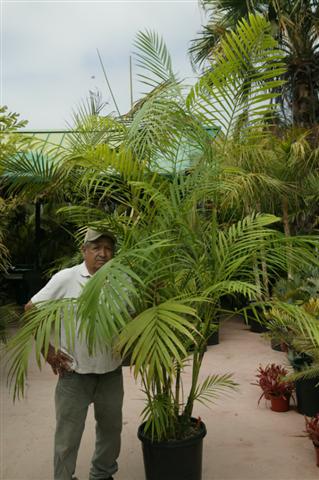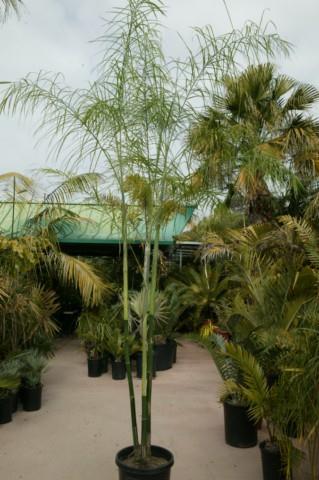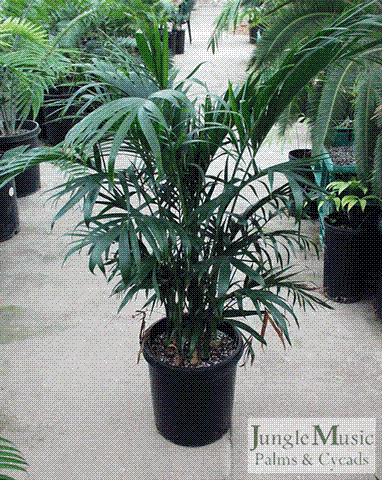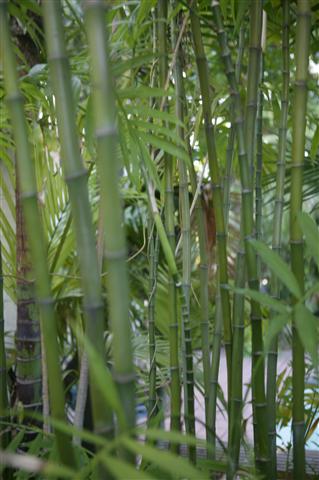Bamboo Palms and the Genus Chamaedorea
INTRODUCTION
For most palm enthusiasts, the term “Bamboo Palm” refers to the a group of suckering palm types that are contained in the genus of Chamaedorea. This family of plants is from the Americas. There are over 100 different species within this group. Specifically Bamboo Palms have been thought of as shade loving palms that have multiple stems, thin reed-like trunks, green pinnate leaves and a smooth attachment at the base of each leaf known as a crown shaft. The reason that certain Chamaedorea are called “Bamboo Palms” is because they sucker like Bamboo and have prominent rings on their trunks.
Historically the most common species thought of as a Bamboo Palm is Chamaedorea seifrizii, from southern Mexico. However, there are many other species of similar Chamaedorea palms that are Bamboo Palms and, in my opinion, are far superior to the classic Chamaedorea seifrizii. This article will discuss the various palms that would be considered “Bamboo Palms” along with their characteristics and differences. Information on culture and growth for both interior and garden usage will be given.



shows beauty and vigor; compare to C. seifrtzii to left
THE BAMBOO PALM IS A MEMBER OF THE GENUS CHAMAEDOREA
This very diverse and wide group of plants called Chamaedorea is native to the New World, mostly from Mexico and Central America. There are a few South American species. With well over 100 different species of Chamaedorea, there are small miniature species and very large species. All are pinnate type (feather leaf) palms although some have modified simple leaves that appear quite different. None are fan palms. Some species sucker and show multiple trunks while others may be single stem. Many have well defined crown shafts, the smooth tissue that surrounds the stem at the base of a leaf. In others, this crown shaft is rudimentary and not well developed. Most species prefer filtered light and in habitat are understory species. However, some will tolerate full sun, especially in coastal environments. Below I will discuss some of these characteristics of this genus.
Below are three photos to show you the wide diversity of the genus (group) Chamaedorea.



CHARACTERISTICS OF THE BAMBOO PALM AND CHAMAEDOREAS
Below is a description of not only the Bamboo Palm, but also the family of Chamaedorea palms. Included will be information on the leaves, stems, flowers and seeds as well as growth habit. This information will help you understand this genus and recognize differences of all the species.
BAMBOO PALM LEAVES – A PINNATE LEAF
WHAT IS A PINNATE PALM?
All Chamaedorea are pinnate leaf palms. Some refer to this as a “feather leaf”. This means that there is a central stem with leaflets coming off the side of that stem. The stem where leaflets are attached is called the rachis. The portion of the stem between the main trunk and the leaflets is called the petiole. Individual leaflets attach to the stem. As a whole, the entire structure is called a “leaf”, composed of many leaflets. Sometimes there are no divisions between the leaflets. When this occurs, it is called a simple leaf, an undivided leaf or a complete leaf. It is actually two leaflets that are seemingly attached in the middle with two terminal and distinct points distally. Of note, the width of leaflets is variable, some being very thin and others quite wide. Sometimes leaflets are grouped in bunches on the rachis. Other times they are widely separated. Sometimes the leaf as a whole is very flat in cross section. Other times the leaflets are projected at various angles from the rachis. This produces a fluffy or plumose type of leaf.
The main distinction here is that Chamaedorea are pinnate type leafs as opposed to a fan leaf. Length of these leaves is quite variable, some being less than 12 inches and others stretching out to almost 8 feet. In contrast, a fan palm leaf has a solid or near solid circular type leaf coming from the end of its leaf stem. Examples of fan palms are given below in the third row of photos.





augustii

CONTRAST PINNATE TO FAN LEAVES BELOW

Coccothrinax species

one from a Pritchardia species

SUCKERING PALM – CLUSTERING PALM
BAMBOO PALMS ARE A SUCKERING PALM: WHAT DOES THIS MEAN?
A suckering palm (multi-stem palm) is one that naturally produces more than one vertical stem or trunk. Typically one trunk will form. At a certain age, from the bottom of the first trunk, additional trunks will appear. As they grow, the first trunk will usually be the tallest of the trunks until maturity is reached. A suckering palm may have two or three trunks or dozens. This formation of new trunks continues typically for the life of the plant but may become less prominent over time. It is important to distinguish this from a single trunk species where the nurseryman puts more than one plant in the same pot. This gives the appearance of a suckering palm but is not one. Such a plant will never increase the number of trunks. In contrast, typically a suckering palm will continually over the years add more trunks to the plant. The classic Bamboo Palm is a suckering species. The photos below show both single trunk and suckering (clustering) palm Chamaedorea.

plant will always have just one trunk.

type of Bamboo Palm



one pot. This number will never change.

BAMBOO PALM TRUNKS
Bamboo Palm trunks tend to be smaller than many of the single trunk varieties. But, if you think about it, this makes sense. Smaller trunks leaves more room for new suckers to find their way up. Average trunk diameters vary from one half an inch to perhaps an inch and a half. One typically sees prominent rings on these trunks – often light colored. Every new leaf formed will give a new ring. Below the leaves are crown shafts (see below) which are the attachment mechanism for the leaves. Flowers also emerge from the trunks. Below are examples of Bamboo Palm trunks.



THE CROWNSHAFT
WHAT IS IT? MANY BAMBOO PALMS HAVE CROWNSHAFTS
This is a term that only applies to pinnate palms as fan palms in general do not posses crown shafts. Crownshafts (sometimes called “crown shaft” as two words) are tubular structures that are actually the proximal or base of a leaf stem. This portion of the stem wraps tightly around the main stem of the plant and forms a typically glossy, smooth structure that encircles the woody trunk. These structures may go around the entirety of the trunk or just part way around the trunk. When an old leaf is removed, this portion can be pulled off with the rest of the leaf. Although crownshafts are not unique to Chamaedorea, many species of this genus do have them. Crownshaft color is typically green when present on Chamaedorea palms. However, colorful crown shafts are seen in other species of palms. Such palms are often quite popular.

species Chamaedorea linearis

genus, Cyrtostachys renda

but covered with a white frost, giving it
a white appearance. Note how this wipes
off after being touched with fingers.
FLOWERS AND SEEDS OF BAMBOO PALMS AND OTHER CHAMAEDOREA
All Bamboo Palms or Chamaedorea species are dioecious. This means that any given plant is either a male or female plant. The flowers of each sex appear morphologically different and it is the characteristics of the flowers that allows taxonomists to determine the species of any given plant. As a rule with most species of Chamaedorea, the male flowers tend to be more branched than the female flowers. But, there are exceptions. Also, the male flowers disperse pollen that makes its way to the female to fertilize the embryos of the female and form seeds. This can be accomplished by wind, insects or mere proximity of the flowers. With some species, large amounts of pollen are formed in the male flowers. A flick of the finger against a mature male flower will produce a cloud of pollen dust that can be seen traveling away from the male. Such a species is Chamaedorea tepejilote. On seeing this, one can understand how wind could carry pollen to a waiting female receptive flower. Other species like Chamaedorea geonomiformis form an almost sticky pollen that doesn’t seem to be wind dispersed.
When flowers form on the trunks of the plants, they are attached to the trunk and near the lowest leaves or interspersed among the base of the leaves. They are often brilliant colors. Many times this color is orange and quite beautiful. After pollination, seeds take anywhere from three to six months to form and the resulting seeds are many colors including black, orange and red. Size of the seeds is variable, but typically about 1/8 to 1/2 inch in size. The colorful layer of fruit around the hard seed is typically removed before germination. Below are pictures of flowers and seeds from the very desirable Chamaedorea benzei. Although a single trunk plant, these are used as multiple plants in one pot to give the suckering appearance. The photos of the flowers are representative of Bamboo Palm flowers.

how the flower is quite branched.

female blossom, C. arenbergiana

this flower is less branched than the male. Very tiny immature fruit is forming.



male blossom of Chamaedorea
stolinifera
THE CLASSIC BAMBOO PALM
Chamaedorea seifritzii
To a novice, a “Bamboo Palm” is any palm that suckers. But, now that you have a little education from descriptions above, you will understand that the classic Bamboo Palm is a thin trunk, suckering Chamaedorea species. A suckering Date Palm is NOT a Bamboo Palm. Most nurseries will use the name “Bamboo Palms” to refer to a suckering, crown shafted Chamaedorea palm. So, if you call around, nurseries may present many different species as a Bamboo Palm.
In the nursery trade, the most commonly grown Bamboo Palm species is Chamaedorea seifrtzii. Here at our nursery we do grow this species, but it far from the most desirable palm that would work as a Bamboo Palm. I say this because this species is susceptible to fungal infections, tends to become lanky over time with sparse leaves, has a general lack of vigor, and has sometimes short unattractive leaves. As a new younger plant, they can be quite pretty (see first photo below). But, over time they lose their appealing appearance. There are other species which are far superior. But, as it’s the “classic” Bamboo Palm, I’ll show it first. But, do read on to “Superior” species below.

Chamaedorea seifrtzii is a fairly attractive
plant.

lanky and sparse. Note the very short
leaves.

seifrtzii. Note how open the crown
of leaves is open and sparse.
SUPERIOR BAMBOO PALMS
Below I will give ideas of what I think are superior thin trunked, suckering Chamaedorea species. All would qualify as being a Bamboo Palm. You can be the judge as to whether they are better species. I will show nursery plants and garden specimens where possible. As you read about them, do note the differences between them all.
CHAMAEDOREA HOOPERIANA
This is a wonderful suckering fan palm that makes a great patio, house or garden plant. It reaches an overall height of ten to twelve feet, has stronger canes and longer leaves than seifrtzii. Cold hardiness is also better and the appearance overall is much fuller and robust. It is also said to be more resistant to disease and less likely to get the fungal problems seen with the classical Bamboo Palm. Because of these factors, we feel it is superior Bamboo Palm than C. seifrtzii.

hooperiana


how full and strong this plant is
CHAMAEDOREA COSTARICANA
This is another very nice suckering Bamboo Palm from Central America. It has similar trunks to the hooperiana but gets taller. Its leaves are about two thirds the length of hooperiana, typically about three feet. But, they are longer and more impressive than C. seifrtzii. It also has more of an open appearance, showing the trunks more than the hooperiana. Typical height is about 12 feet and clumps are very nice. So, like C. hooperiana, this species is felt to be superior to the classic Bamboo Palm above.

are a similar caliber compared to
hooperiana, but the overall appearance
is sometimes more open as seen here on
this nursery plant. Also, the leaves are
a bit shorter than hooperiana.

it has a more open appearance. Note how
this plant is growing in presumed full sun.

tall in a garden setting
CHAMAEDOREA CATARACTARUM
Sometimes this palm is referred to as the Dwarf Bamboo Palm. It comes from Mexico and lives in wet habitats near river edges. The term “catactarum” is referenced to the fact that this plant lives near rivers and likes water. It is known in the trade as the Cat Palm. It rarely gets a height above five feet. If it sees dry air or is not heavily watered, it tends to do poorly and get develop tip burn to the leaves. Also, it doesn’t seem to like the dryer interior environment inside a house. We’ve found as a nursery product, it is inferior to the two above. But, it has the advantage of better tolerating sun.



CHAMAEDOREA MICROSPADIX
This is a medium sized Bamboo Palm with thin reed-like trunks, small to medium length leaves and a very open appearance. In my experience it grows to a height of about 8 feet, although plants to twelve feet have been reported. Often its leaves have an iridescent sheen to them and sometimes the underside is a glaucous silver color. Because of the very thin trunks, stems on mature clumps will often lean out from the central area of the clump. Fruits on females are plentiful with a bright red color, often with clusters of seeds hanging among the leaves. Another feature of this palm is its cold hardiness, reported to tolerate temperatures into the upper teens. For those living in a colder area, this might be the perfect Bamboo Palm. In more recent years, this species has been difficult to find.

microspadix, another type of Bamboo Palm.

to the leaves of Chamaedorea
microspadix.

shot shows how stems lean outwards, opening up the crown of leaves.
CHAMAEDOREA HYBRIDS
Over the past several decades, nurserymen have developed many hybrids, looking for a superior Bamboo Palm. This is done by taking pollen from a male species and applying this pollen to a receptive female palm. The first name in the hybrid represents the seed bearing female. One famous cross was called the Irvine Cantor Hybrid. This was a cross between Chamaedorea costaricana and Chamaedorea pochutlensis. Both of these parent suckering Chamaedorea species were very nice in their own rite. The cross was meant to give a tall, prettier hybrid. One of my personal favorite hybrids was a cross between Chamaedorea costaricana and “Chamaedorea schippii“. The latter is an unrecognized variety of costaricana with very thick canes. This cross gave powerful thick trunks with nice height and fullness.

very desirable hybrid Bamboo Pal


GROWING BAMBOO PALMS
Bamboo Palms are not difficult to grow. As a rule, assume that they like filtered light or shade. Sometimes they will tolerate some sun, but this is perhaps the exception for most localities. They prefer good draining soil and adequate root room in their container in grown in a pot. In general, one should not allow the soil to become overly dry. Typically watering outdoors is once to three times a week when the weather is warm. A mild slow release fertilizer should be applied about three times per year. Try not to use a quick release fertilizer if possible as this can lead to leaf damage. Cold tolerance for most species is into the upper twenties, F. Chamaedorea microspadix is the most cold hardy of those species described above. If you are attempting to grow any of these species from seeds, clean off the fruit before potting them up. Germination typically takes about three to six months. Below are a few pictures of perfect locations in the garden for Bamboo Palms.

perfect location for Chamaedoreas.

ideal for an assortment of Bamboo Palms

also perfect for these shade palms.
INTERIOR CULTURE OF BAMBOO PALMS
Interior growing of Bamboo Palms can be successful and satisfying if simple rules of culture are followed. It would be best if these plants are not placed directly in front of a high intensity window where they’d get too much light. Indirect light is usually adequate. During winter when a furnace is utilized, the ambient air often has low humidity. This can lead to leaf damage or tip burning. Spraying the plants with misted water can help. One final point about culture would deal with the quality of the water you are using to water the plant. Municipal and well water are known to often have high salt content. This can lead to decline of the plant over time. Therefore, we recommend using distilled water or water from a reverse osmosis unit. If this is not possible, consider taking the plant outdoors several times a year and leaching the soil with about 20 cycles of water to the soil.
CONCLUSION: BAMBOO PALMS
The term “Bamboo Palms” refers to any of a whole group of suckering, thin trunked and prominently ringed Chamaedorea palms. They are not just any palm tree that has suckers or multiple trunks, but specifically species from the genus Chamaedorea. The trunks of the Bamboo Palm tend to be thin. vertical with prominent rings, thus resembling a Bamboo. This is why they have received this name. There are over a hundred different types of Chamaedorea, and approximately six or eight could be considered Bamboo Palms. To the novice, any palm that suckers and is multi-stemmed is a Bamboo Palm. But, a true Bamboo Palm is always a Chamaedorea. The species Chamaedorea seifrtzii is the most classically referred to and utilized species of Bamboo Palm. But, it is far from the best species for either garden usage or in the house. This article shows examples of multiple other species or hybrids that the reader will find more desirable and easier to grow. Of these, we have found that Chamaedorea hooperiana, costaricana, microspadix and a few others are ideal from an appearance and cultural point of view. Culture of the Bamboo Palm is not difficult. Most require adequate water and filtered light. In the house, this should be indirect light. Interior growth is easily accomplished if humidity and water are maintained. Mature heights of most species that qualify as Bamboo Palms is eight to fourteen feet. Links are given below for more information on these types of palm trees.

closer view of the leaves from above

Bamboo Palms with its many trunks.

Thank you for reading this article. We’ll try to update some photos over time. For more information on Chamaedorea with lots of photos of the species, click below on two more articles on the subject.
Phil Bergman
Owner
- PALM TREES, CYCADS & TROPICAL PLANT BLOG - October 1, 2020
- TRACHYCARPUS
The Windmill Palm - September 30, 2020 - FAN PALMS –
PALMS WITH CIRCULAR LEAVES - September 29, 2020












